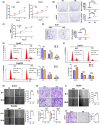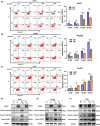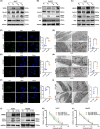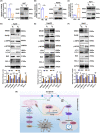NR0B1 augments sorafenib resistance in hepatocellular carcinoma through promoting autophagy and inhibiting apoptosis
- PMID: 37991109
- PMCID: PMC10859617
- DOI: 10.1111/cas.16029
NR0B1 augments sorafenib resistance in hepatocellular carcinoma through promoting autophagy and inhibiting apoptosis
Abstract
NR0B1 is frequently activated in hepatocellular carcinoma (HCC). However, the role of NR0B1 is controversial in HCC. In this study, we observed that NR0B1 was an independent poor prognostic factor, negatively correlated with the overall survival of HCC and the relapse-free survival of patients treated with sorafenib. Meanwhile, NR0B1 promoted the proliferation, migration, and invasion of HCC cells, inhibited sorafenib-induced apoptosis, and elevated the IC50 of sorafenib in HCC cells. NR0B1 was further displayed to increase sorafenib-induced autophagic vesicles and activate Beclin1/LC3-II-dependent autophagy pathway. Finally, NR0B1 was revealed to transcriptionally suppress GSK3β that restrains AMPK/mTOR-driven autophagy and increases BAX-mediated apoptosis. Collectively, our study uncovered that the ectopic expression of NR0B1 augmented sorafenib-resistance in HCC cells by activating autophagy and inhibiting apoptosis. Our findings supported that NR0B1 was a detrimental factor for HCC prognosis.
Keywords: NR0B1; apoptosis; autophagy; hepatocellular carcinoma (HCC); sorafenib resistance.
© 2023 The Authors. Cancer Science published by John Wiley & Sons Australia, Ltd on behalf of Japanese Cancer Association.
Conflict of interest statement
The authors declare no conflict of interest.
Figures






Similar articles
-
SNGH16 regulates cell autophagy to promote Sorafenib Resistance through suppressing miR-23b-3p via sponging EGR1 in hepatocellular carcinoma.Cancer Med. 2020 Jun;9(12):4324-4338. doi: 10.1002/cam4.3020. Epub 2020 Apr 23. Cancer Med. 2020. PMID: 32324343 Free PMC article.
-
Vaccinia-related kinase 2 blunts sorafenib's efficacy against hepatocellular carcinoma by disturbing the apoptosis-autophagy balance.Oncogene. 2021 May;40(19):3378-3393. doi: 10.1038/s41388-021-01780-y. Epub 2021 Apr 19. Oncogene. 2021. PMID: 33875785
-
Melatonin Increases the Sensitivity of Hepatocellular Carcinoma to Sorafenib through the PERK-ATF4-Beclin1 Pathway.Int J Biol Sci. 2019 Jul 21;15(9):1905-1920. doi: 10.7150/ijbs.32550. eCollection 2019. Int J Biol Sci. 2019. PMID: 31523192 Free PMC article.
-
Upregulation of lncRNA NIFK-AS1 in hepatocellular carcinoma by m6A methylation promotes disease progression and sorafenib resistance.Hum Cell. 2021 Nov;34(6):1800-1811. doi: 10.1007/s13577-021-00587-z. Epub 2021 Aug 10. Hum Cell. 2021. PMID: 34374933 Review.
-
Multiple Roles of Autophagy in the Sorafenib Resistance of Hepatocellular Carcinoma.Cell Physiol Biochem. 2017;44(2):716-727. doi: 10.1159/000485285. Epub 2017 Nov 23. Cell Physiol Biochem. 2017. PMID: 29169150 Review.
Cited by
-
AMPK: The energy sensor at the crossroads of aging and cancer.Semin Cancer Biol. 2024 Nov;106-107:15-27. doi: 10.1016/j.semcancer.2024.08.002. Epub 2024 Aug 26. Semin Cancer Biol. 2024. PMID: 39197808 Review.
-
Targeting STK26 and ATG4B: miR-22-3p as a modulator of autophagy and tumor progression in HCC.Transl Oncol. 2025 Jan;51:102214. doi: 10.1016/j.tranon.2024.102214. Epub 2024 Nov 27. Transl Oncol. 2025. PMID: 39608212 Free PMC article.
-
Dendritic Cell-Related Gene Signatures in Hepatocellular Carcinoma: An Analysis for Prognosis and Therapy Efficacy Evaluation.J Hepatocell Carcinoma. 2024 Sep 17;11:1743-1761. doi: 10.2147/JHC.S481338. eCollection 2024. J Hepatocell Carcinoma. 2024. PMID: 39309303 Free PMC article.
-
Targeting cell death mechanisms: the potential of autophagy and ferroptosis in hepatocellular carcinoma therapy.Front Immunol. 2024 Sep 9;15:1450487. doi: 10.3389/fimmu.2024.1450487. eCollection 2024. Front Immunol. 2024. PMID: 39315094 Free PMC article. Review.
References
MeSH terms
Substances
Grants and funding
LinkOut - more resources
Full Text Sources
Medical
Molecular Biology Databases
Research Materials
Miscellaneous

